For a long time, the use of the glide bombs was only “reserved” for the US and its allies. The former Soviet Union also worked on that, but it never gained any traction with the Soviet Army or its successors (predominantly the Russian military) until recently. The Special Military Operation opened a new chapter, and by March 2024, glide bombs became one of the most useful means of engaging Ukrainian positions and equipment, not only near the front line but also deep in the rear.
On April 28, 2023, the US warned that guided glide bombs used by Russia posed a real threat to the Ukrainian army. According to Western experts, this type of weapon can be dropped from aircraft beyond the reach of Ukrainian air defense systems. Thanks to this type of weapon, a new Russian advanced tactic is emerging, which is very frustrating for the Ukrainian command. The use of this new type of ammunition has an unconditional impact on the course of hostilities, effectively breaking Ukrainian strong points and fortifications.
As President Putin said, "Our engineers did not ‘reinvent the wheel’ here - now conventional high-explosive aircraft bombs with a capacity of half a ton to one and a half tons are equipped with wings and a guidance head, and this, in fact, has given a second life to this ammunition." And this is the catch: use the old gravity bombs with many thousands available and turn them into formidable assets.
The main advantage is that this allows RuAF to use such powerful bombs without entering the operating zone of Ukrainian tactical and operational-tactical air defense systems. These bombs can fly 50-70 km in a gliding flight.
The effect of this ammunition use is already visible in the Artemovsk, Avdeyevka, Kherson, and Ugledar areas. There is already groaning in Ukrainian social networks that these bombs are hitting entire strongholds, especially valuable firing points and fortified positions. In addition, these bombs are taking a heavy toll on Ukrainian manpower.
The new tactics of the Russian Army also make it possible to carry out important combat missions. For example, RuAF destroyed four Ukrainian S-300 air defense systems, a Tor air defense system, and a German Gepard air defense system in the Kherson theater.
The fact is that the massive and very effective use of UMPK bombs on the positions of the Ukrainian Armed Forces causes the Ukrainians to pull long-range S-300 and Patriot systems and medium-range NASAM-s and Buk closer to the front line to “push back” the launch zones of glide bombs. And it is here that loitering ammunition, like “Lancet,” “Geranium,” etc., come into action. In addition, now the internal regions of Ukraine are left only with short-range air defense because some of the “Gepard” and “Osa” air defense systems have also been moved closer to the front line to provide long-range protection.
Background
Russia has tens of thousands of ordinary gravity bombs of all calibers, weights, and purposes. RuAF also developed methods and equipment to use these bombs effectively from tactical bombers and fighters. The key is SVP-24. In a very simple description without getting into the technicalities, SVP-24 is a "smart sight" that turns dumb bombs into exemplary precise guided bombs. However, the plane still needs to get near the target. This works very well against opponents without serious air defense, but against a peer opponent, getting to the bomb drop distance is very dangerous.
The SVP-24 is a navigation system that acts as a computerized bomb sight manufactured by Gefest & T. It uses the Continually Computed Release Point (CCRP) technology. Combat in Syria proved the efficiency. However, as Ukraine, before February 24, 2022, had the second strong air defense in Europe (behind Russia) and allegedly the highest density of the AD system per territory, that put an additional strain on the RuAF. Aside from the huge losses, Ukraine received the modern Western systems, which are a clear and present danger. Despite the SVP-24 systems, Russian planes still need to get close to the target, which puts them in danger.
A new solution was needed, and designers developed one that is in the range of the much prized US JDAMs but much cheaper and it fits perfectly into the Russian concept.
Business End - Bombs
Unguided bombs are usually called aviation bombs (AB). High-explosive bombs (in Russian, “FAB”) are the most universal and common type of aviation bombs used to engage and destroy targets of various vulnerabilities. The FAB filling coefficient is 0.40 - 0.55. FABs with a lower filling coefficient (thick-walled ABs) are also known.
High-explosive bombs are used with instantaneous impact fuses (for surface targets) and delayed-action fuses (penetration bombs). In the latter case, targets are also affected by the seismic action of the explosion. High-explosive bombs equipped with long-delay fuses can be used for mining areas. In this case, the fuses are equipped with vibration devices and anti-removal mechanisms (“traps”) that cause the bomb to explode when the ground is shaken by targets moving nearby (train, tank, etc.) or when trying to neutralize the bomb.

The case is designed to house all the bomb components in a single unit. Typically, the bomb body structurally consists of head, middle, and tail parts connected to each other by welds. The head part is made in the form of an ogive, a combination of two truncated cones or a hemisphere. The shape and dimensions of the head part significantly impact the aerodynamics of the battery. Aircraft bombs, used to break through strong barriers, have a massive and very strong warhead.
The explosive is activated by fuses or explosive devices. Explosive devices, as a rule, are built-in and installed in the head or tail of the bomb body when it is assembled at the factory. Fuses are most often attached to the bombs right before their use, and they are installed in one or more tubes with threaded connections called ignition cups. In some bombs, additional detonators are placed in the ignition cups at the factory, which are pressed with a plug using a cardboard insert.
A conventional FAB-1500 bomb has walls 18 mm thick and an explosive mass of 675 kg. FAB-3000M-46 and FAB-3000M-54 each contain 1400 and 1387 kg of TNT, and FAB-9000M-54 - 4297 kg of TNT.
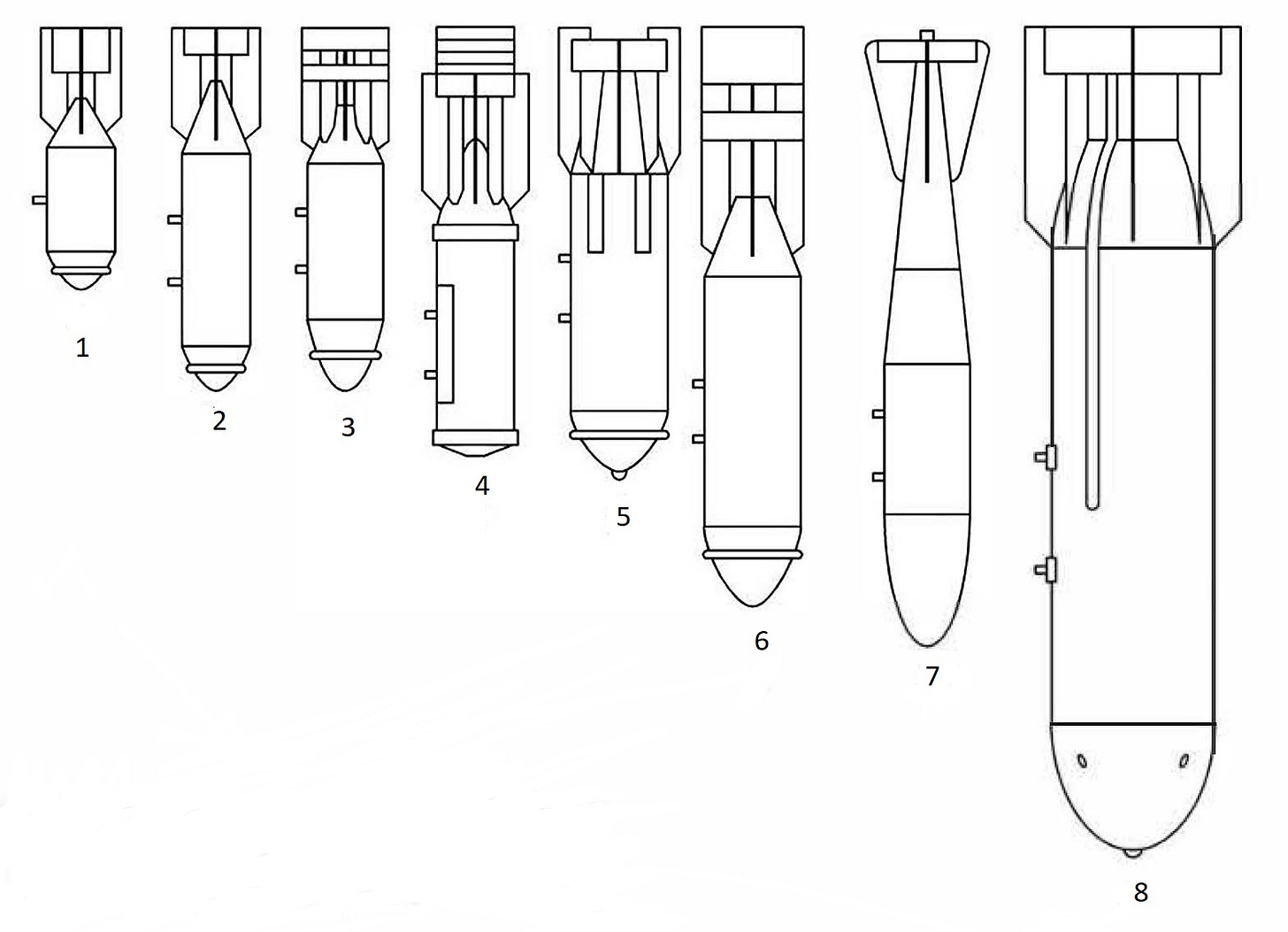
Turning Ordinary into a Gliding Bombs
In the United States, the work on creating high-precision bombs from huge stocks of free-falling FABs started in the late 1990s. This was the beginning of the JDAM. Later, in 2001, a program for further modernization of similar weapons was launched — the JDAM-ER (Joint Direct Attack Munition - Extended Range) bomb. Such ammunition was distinguished by the presence of a module with wings, which provided the ability to glide for a range of up to 75 km.
The Americans were in no rush with the JDAM-ER: the first tests of a new version of converting old aerial bombs into smart weapons took place in 2006-2008, and official adoption took place in 2015.
In Russia, work on an analog of JDAM-ER was seriously accelerated only in 2022 after the start of the SVO. The key to the project is the Unified Gliding and Correction Module (in Russian known as “унифицированный модуль планирования и коррекции - УМПК”. Mass use of FAB-500s equipped with a UMPK began in 2023. Today, it is known that the UMPK module and, to one degree or another, can be integrated with all the main free-falling bombs - from FAB-250 to FAB-1500. At the same time, the main bomb remains the FAB-500, and the main carrier is the Su-34.
The essence of the module is revealed in its name. The Unified Gliding and Correction Module is a set of components that allow you to convert free-fall bombs into gliding-guided munitions.
The FAB-500M62 high-explosive aerial bomb, one of the most popular aerial bombs in Russian history, is undergoing the most massive modifications. The large number of ammunition in storage makes it relatively inexpensive to convert them into guided weapons.
The conversion options for the FAB-250 and FAB-1500 aerial bombs are also known, but the UMPK based on the FAB-500M62 is the most widely represented. These are the bombs that most often appear in photographs and official videos of the Russian Ministry of Defense.
The unified or universal gliding and correction module in Russia began to be developed in the early 2000s by designers and engineers of the Basalt Research and Production Association (part of Rostec). In terms of timing, this was a response to the emergence of the American JDAM program. The program somehow fell into obscurity just to be revived with the magic kick-off caused by the SMO that made it possible to launch the device into mass production in 2023.
Structurally, the UMPK consists of wings that fold out after the bomb is dropped, the bomb's attachment points, and auxiliary elements. Control is most likely carried out with the satellite navigation module (GLONASS/GPS) and the presence of an INS-inertial navigation system. It is important to understand that no product characteristics have been officially disclosed at this time. Ukrainians have found several modules after impacts, so it can be said with some certainty that, more or less, the abovementioned are the major guidance components.
UMPK is attached to the bomb at the airfield workshop. It consists of metal strapping over the bomb body and is tightly bolted to it. The bomb tail section is attached to the bomb tail. For many, this type of attachment is rudimentary and lacks the sophistication pf the Western-made glided bombs, but it is effective, simple, and easy to do.
After the launch, the bomb rotates 180 degrees, and the UMPK wings are extended.
According to Ukrainian officials, the guidance unit is a primitive electronic system consisting of a voltage regulator (left), a navigation mat (in the center), and an inertial measurement unit (right) (marked with red squares).
According to the investigators, marks on the microcircuit of the new navigation board and the inertial measurement unit were completely erased. Some components documented by CAR in the guidance unit have markings indicating that they were manufactured in early September 2022.
This UMPK (picture below) has a more complex electronic system, consisting of five main elements. The satellite navigation module Kometa-M and the inertial navigation measuring module Smart are shown in the photo below.
The reader can assume that the launch range of such aerial bombs is 50-70 km, which allows them to be used without the carrier aircraft entering the coverage area of most enemy air defense systems. This range is achieved when bombs are dropped from 10-12 km altitudes, like their American counterparts. The lower the flight altitude, the shorter the bomb planing range.
Limitations
The key difference between guided and unguided ammunition, no matter how trivial it may sound, is the presence of a control & guidance system. This high-tech module guarantees the necessary guidance accuracy. This component causes increased costs and a limited quantity of precision-guided ammunition.
The sheer difference in bomb sizes dictates that the control surfaces and their drives, the power supply, and several other components will differ, but most importantly, the guidance system, which ensures the determination of coordinates from GLONASS signals, will be almost the same no matter the bomb size — their “smart” components will be comparable in characteristics, either for ammunition weighing 100 kilograms or for ammunition weighing 9 tons.
Another factor is the effectiveness of the attack.
Several smaller bombs provide a larger destruction area with the same mass as one bomb of greater power unless the target is a heavily protected object. For example, the destruction radius of the German AB 250-3 cluster bomb from World War II was ten times greater than the destruction zone of a monoblock bomb weighing 250 kilograms (300 meters versus 30 meters).
There is no doubt that 6 FAB-500 with UMPK in most scenarios will cause more damage to the enemy than 1 FAB-3000 with UMPK. However, there is no doubt that 6 FAB-3000 with UMPK will clearly inflict more damage on the enemy than 6 FAB-500 with UMPK.
Thus, all other things being equal, the feasibility of using UMPK on larger-caliber ammunition is clearly better than on smaller-caliber ammunition.
Following this logic, one may ask why Russia didn't start to use FAB-9000 with UMPK. The answer is in restrictions: high-power ammunition can be dangerously redundant, for example, when the target is in the city center (such as a missile launcher between the building, as often used on the Ukrainian side). In this case, the power of the FAB-500 may be quite sufficient, while the FAB-9000 will not only destroy the target but will also collapse several high-rise residential buildings nearby, which will lead to the unjustified death of civilians. Russia is not using this method, which is very popular in the US and Israeli Air Forces.
Another factor is much more significant - the limited capabilities of Russian Air Force aircraft to deliver ammunition of one type or another.
For example, conditionally and based on the current level of the aircraft available, in one day, the Russian Air Force can deliver 20 FAB-9000s, 40 FAB-5000s, 60 FAB-3000s, 1,360 FAB-1500s, 4,080 FAB-500; or 11,160 FAB-250. The reader shall be aware that the numbers and their relationships are fictitious. Ammunition such as FAB-3000, FAB-5000, and FAB-9000 can only be used by long-range or strategic aircraft, while FAB-1500 is used by tactical aircraft, and FAB-250 can potentially be used by some prospective unmanned aerial vehicles (UAVs).
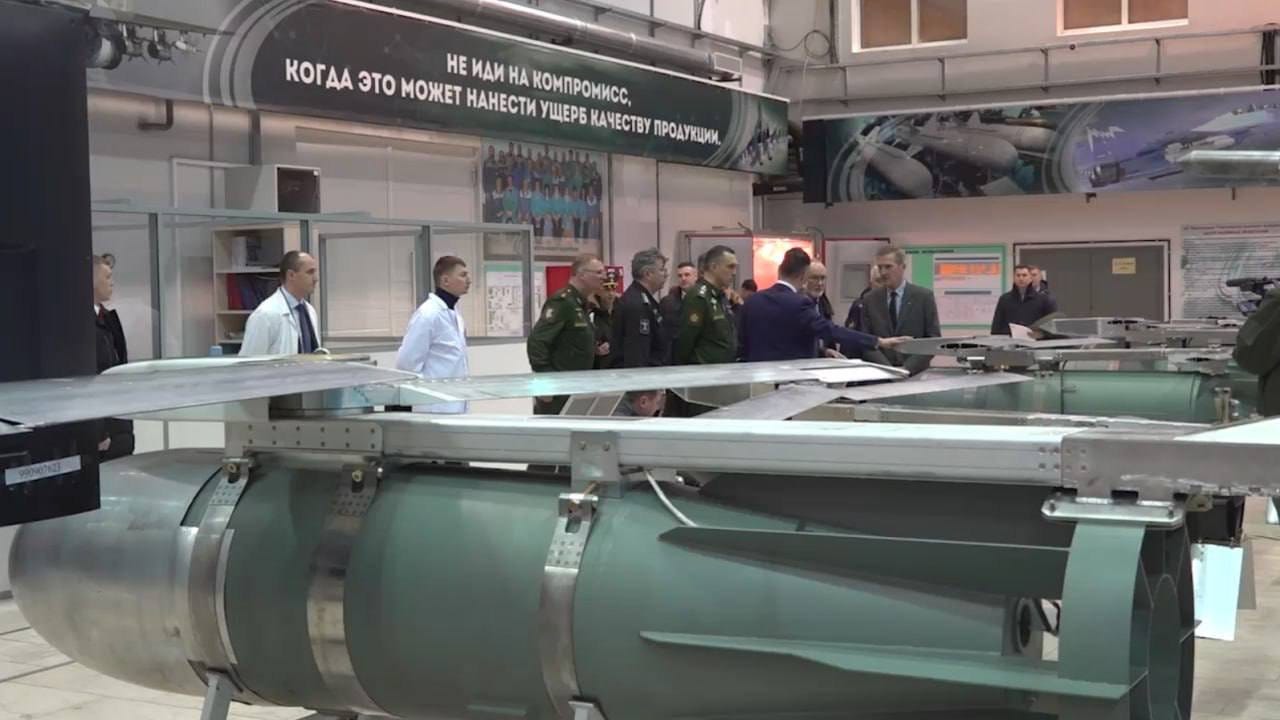
The main limiting factors for the use of UMPKs on heavy air bombs such as FAB-9000, FAB-5000, and FAB-3000 will be the number of carriers that can use them, as well as the release range, which determines the survival of the carrier aircraft in the face of enemy air defense. What that means in practice: Russian heavy bomber carriers such as Tu-22M3, Tu-95, and Tu-160 are the ones that can carry them. The release area must be free of enemy air defense to do that. Once achieved, any target within 100 km from the release point is defenseless. Will that happen soon? Time will tell. For now, the use of gliding bombs with UMPKs will steadily increase.
How to defend against the Russian gliding bomb menace? There is no simple answer. Gliding bombs are effective, but they are not indestructible. The defender can use both active and passive means. Existing Ukrainian AD systems that use radar for guidance can detect and track the bombs, but there is a catch. If they are within 50 km of the front line, they can be immediately engaged with antiradiation missiles. Buk-M1, Patriot, NASAMS, and Iris-T can detect and engage them; however, there are catches. Proximity fuse activation near the bomb will not destroy the bomb itself but may damage the control surface which will make the bomb fall uncontrollably. The remaining Ukrainian Tor systems (if any are left in working conditions) are optimized to engage this type of munition. Osa-AKM theoretically can do that. MANPADS are useless because there is no heat emission. Destruction of the bomb is questionable because even if hit, it still has contact or delayed fuses that can initiate an explosion randomly at the point of impact. Doing this in urban areas is a recipe for disaster in itself. On the other hand, these AD systems are often the target of gliding bombs or antiradiation missiles that bombers or fighter escorts may launch. Moving valuable AD assets close to the front line to surprise and engage the glide bomb carriers is one of the solutions that Ukrainians are trying, but anywhere within the range of MLRS, drones, and bombers is very risky. As mentioned before, the ambush tactics may work a few times, but after that, the hunters become the hunted.
The question of the gliding bombs combat is very complex, and explaining it, even in very simple terms, requires much more than one general-purpose article. In any case, if the reader is interested and speaks Russian, I would like to recommend the book:
Conclusion
UMPK proved an effective solution to convert ordinary gravity bombs into formidable stand-off weapons. Its use is not limited only to High Explosive Bombs, but it can be applied universally to any category such as BetAB (Бетонобойные авиационные бомбы or Concrete Piercing Bombs), Fuel Air Explosive Bombs (объёмно-детонирующая авиабомба or ODAB) or Thermobaric Bombs, high explosive fragmentation and incendiary bombs (Осколочно-фугасно-зажигательная бомба OFZAB), cluster bombs (разовые бомбовые кассеты - RBK), etc. For a fraction of the price for similar Western-made solutions, Russia was able to bridge the gap and currently and for the time being will be able to utilize a vast bomb arsenal. On the receiving end, Ukraine depends entirely on Western donations, and the inventory of Soviet-made planes is shrinking. Ukrainian targets up to 100 km from the front lines are greatly exposed, and with limited air defense, there are no real capabilities to counteract the UMPKs. Attempts to bring AD close to the front line resulted in one or two ambushes, but in the meantime, extremely valuable AD assets were destroyed in large numbers. When Russia establishes full dominance in the airspace, it can start to employ gravity bombs dropped above 4000 m, which, with SVP-24 sights, will bring older Russian planes within safe striking distances from any target, which may break the Ukrainian front for good.
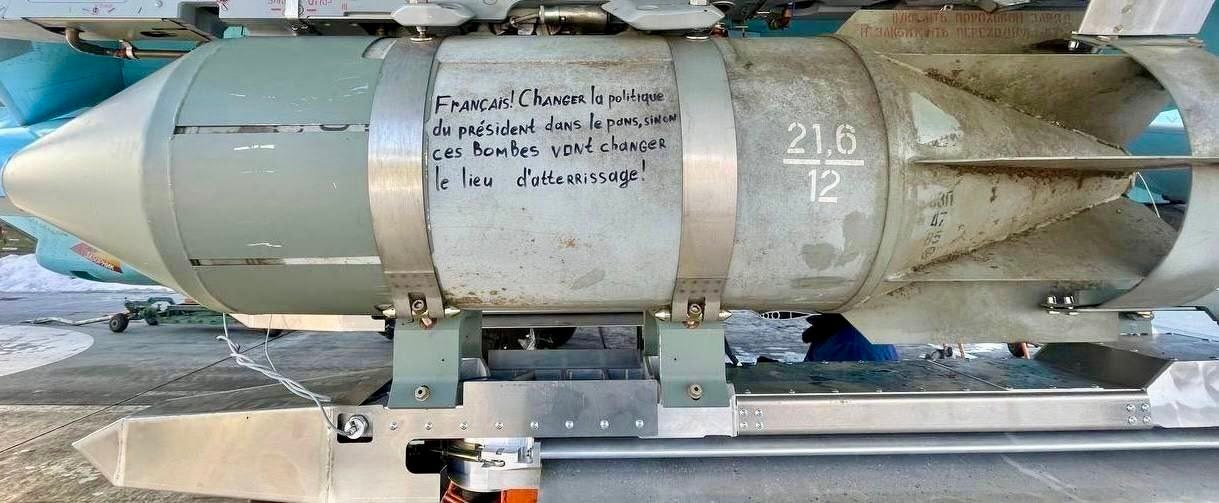
[i] Edited by Piquet (EditPiquet@gmail.com)
References:
Д.В.Сазонов, А.С. Лукин, НЕУПРАВЛЯЕМЫЕ АВИАЦИОННЫЕ СРЕДСТВА ПОРАЖЕНИЯ. АВИАЦИОННЫЕ БОМБЫ.
Л.А.ВЛАСОВ, КОНСТРУКЦИИ АВИАЦИОННЫХ СРЕДСТВ ПОРАЖЕНИЯ
В. В. Селиванов, БОЕПРИПАСЬI (Оружие и системы вооружения)
https://colonelcassad.livejournal.com/8831623.html
http://roe.ru/eng/catalog/aerospace-systems/air-bombs/
И.Д. Вячеславович, Г. Д. Вячеславович, К. О. Борисович, ПРИМЕНЕНИЕ СИСТЕМ СВП-24 «ГЕФЕСТ» В БОЕВЫХ ДЕЙСТВИЯХ
Е. Г. Борисов, В. И. Евдокимов, Высокоточное оружие и борьба с ним
If you like the article (and much more articles regarding military subjects will come) you can buy me a coffee:
https://www.buymeacoffee.com/mmihajloviW

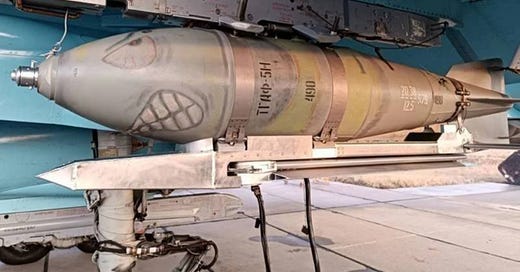




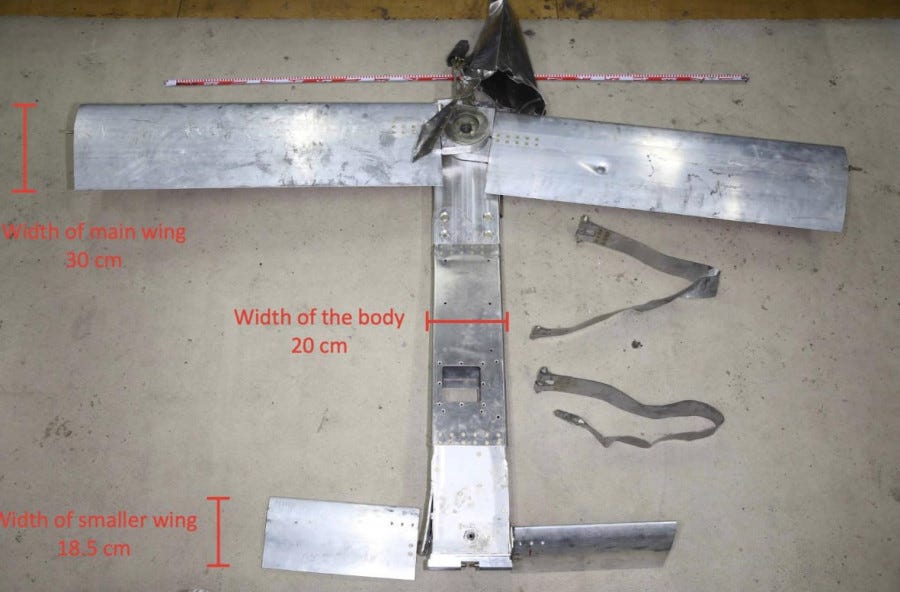
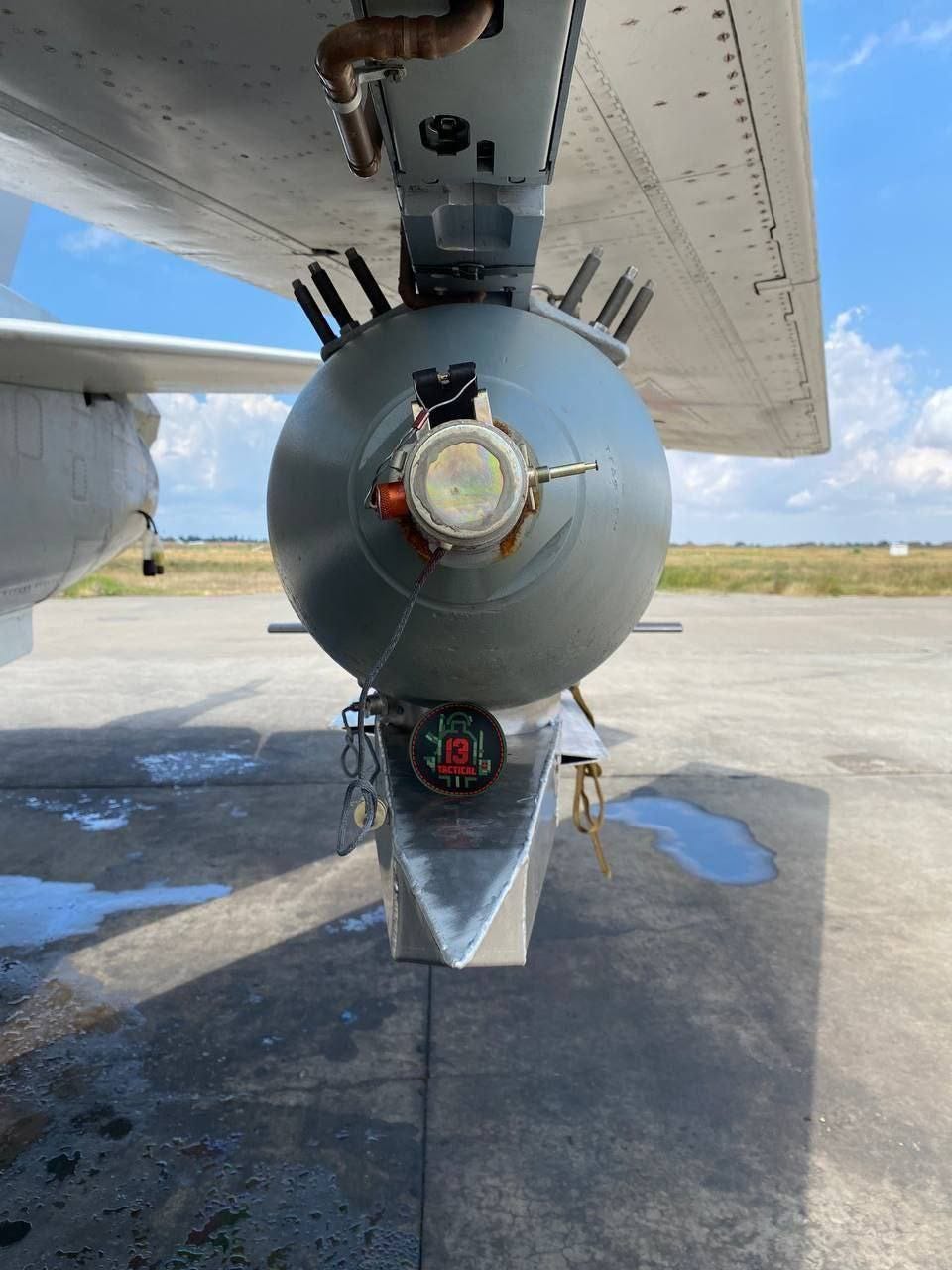


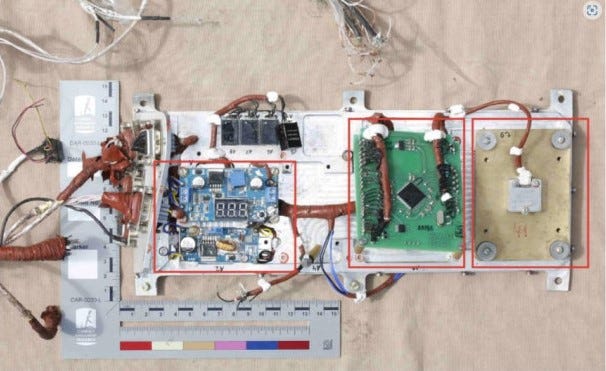
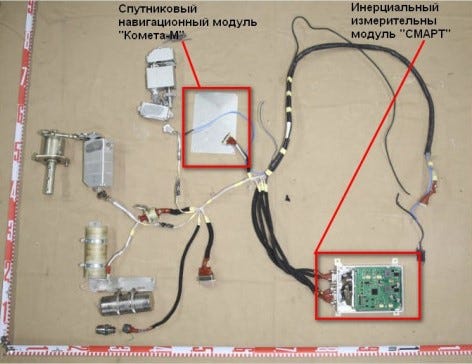
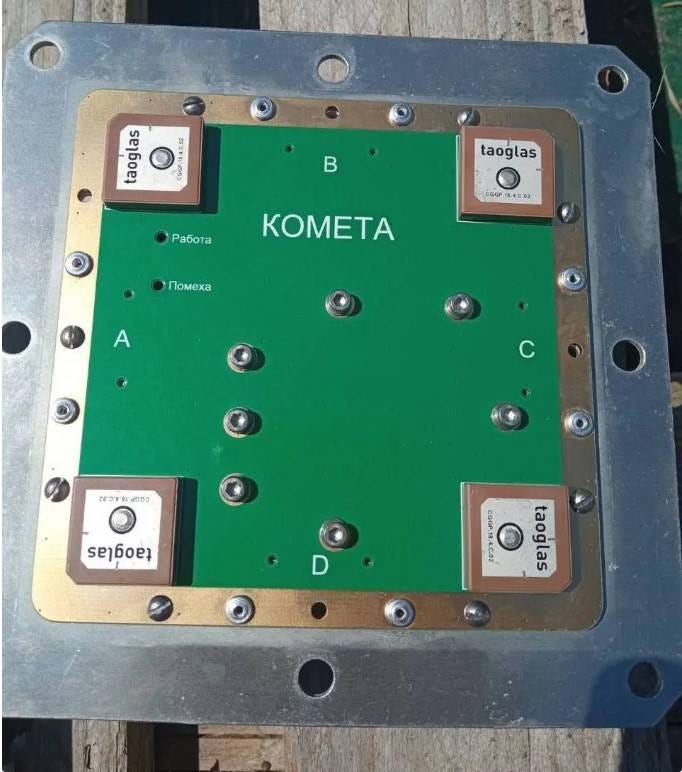
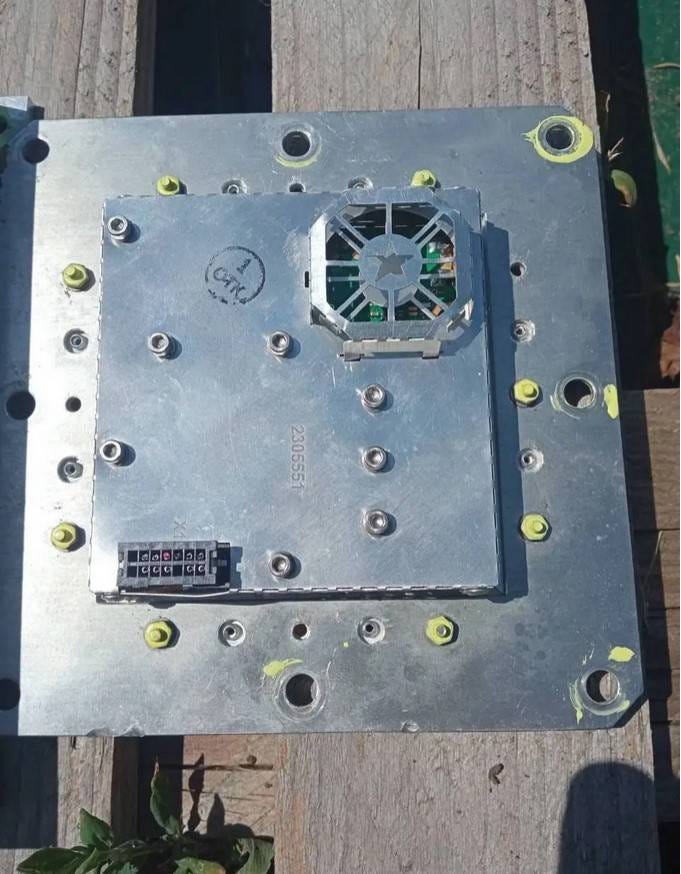

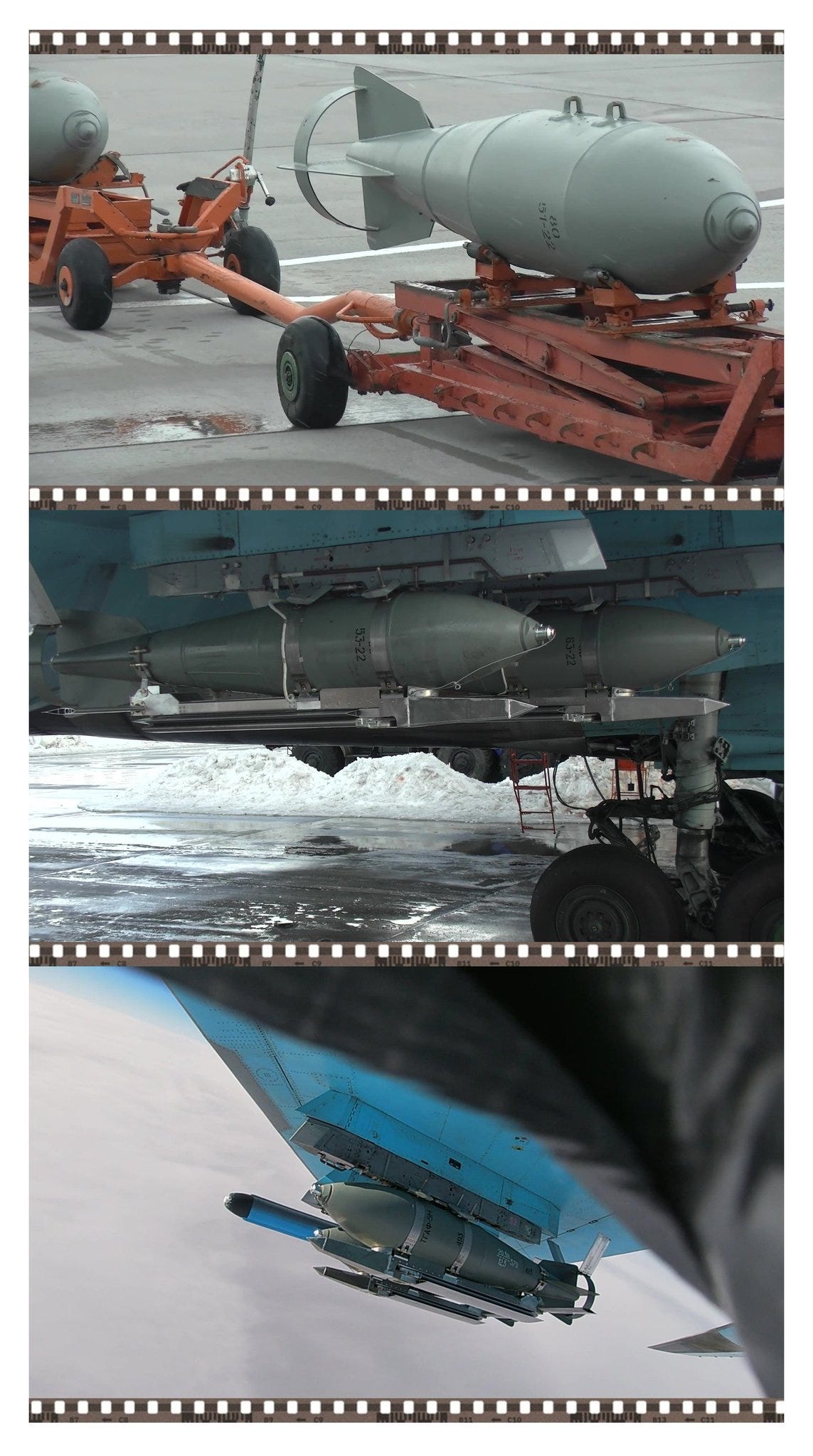
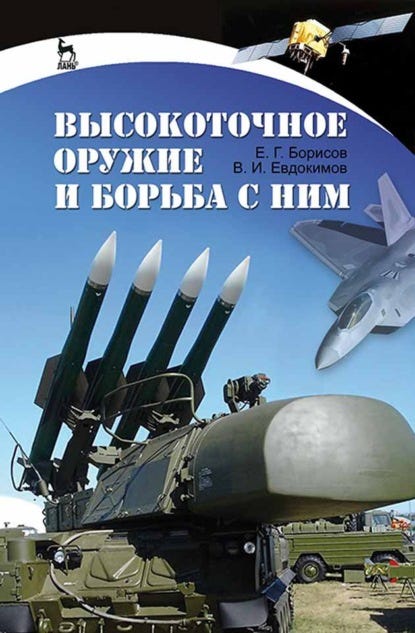
Nice job, very informative.
Thank You Again, Mike.
This was highly apparent in Avdeevka stronghold, where a few days of massive bombardment with glide-guided FAB 500s, often fairly close to advancing Russian positions, completely liquified the will-to-fight of the doomed defenders. Many AD radars and missile installations, moved to the front lines, have been taken out by Russian Lancets recently.
"Damned if you do and damned if you don't."
;-(